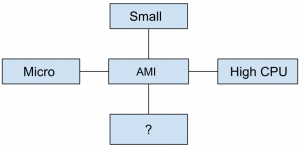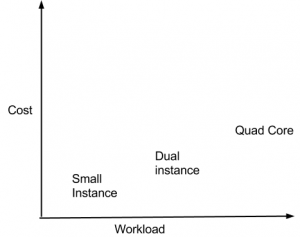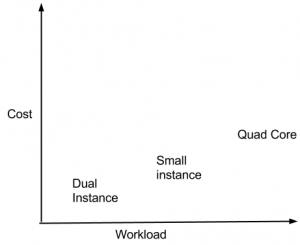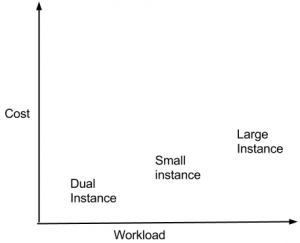This set of Cloud Computing Multiple Choice Questions & Answers (MCQs) focuses on “Server and Instance types”.
1. Which of the following type is missing in the following figure?

a) High-CPU
b) High-Disk
c) High-ROM
d) All of the mentioned
View Answer
Explanation: In cloud computing, you can often increase capacity on demand quickly and efficiently.
2. Point out the correct statement.
a) Use of different machine instance sizes is an attempt to create standard servers
b) Reducing the variability between servers makes it easier to troubleshoot problems and simpler to deploy and configure new systems
c) A server with the same set of software, system configuration, and hardware should perform similarly if given the same role in an infrastructure
d) All of the mentioned
View Answer
Explanation: As much as possible, you also should assign servers standardized roles and populate those servers with identical services.
3. Which of the following instance has 68.4GB of memory and 26 EC2 Compute Units?
a) High-Memory Quadruple Extra Large Instance
b) Small Instance
c) Micro Instance
d) High-CPU Extra Large Instance
View Answer
Explanation: I/O Performance is high and API name is m2.4xlarge.
4. Which of the following instance is used by default in AMI?
a) High-Memory Quadruple Extra Large Instance
b) Small Instance
c) Micro Instance
d) High-CPU Extra Large Instance
View Answer
Explanation: Small Instance has 1.7GB memory and 1 EC2 compute unit.
5. Point out the wrong statement.
a) In practice, there is less performance variability in cloud machine instances
b) Capacity planning seeks to compare the capability of one system against another system
c) Capacity planning provides the service with the best operational parameters at the lowest cost
d) All of the mentioned
View Answer
Explanation: This variability may be due to your machine instances or storage buckets being moved from one system to another system.
6. Which of the following graph correctly describes relative costs and efficiencies of different physical and virtual servers?
a) 
b) 
c) 
d) None of the mentioned
View Answer
Explanation: This type of graph allows you to add the appropriate server type to your infrastructure while performing a cost analysis of the deployment.
7. Which of the following instance has an API name: m2.4xlarge?
a) High-Memory Quadruple Extra Large Instance
b) Small Instance
c) Micro Instance
d) High-CPU Extra Large Instance
View Answer
Explanation: High-CPU Extra Large Instance has 7GB of memory and 20 EC2 Compute Units.
8. EC2 Compute Unit is the equivalent of a _____ GHz 2007 Opteron or 2007 Xeon processor.
a) 1
b) 2
c) 4
d) All of the mentioned
View Answer
Explanation: We may add or substitute measures that go into the definition of an EC2 Compute Unit.
9. Which of the following instance has the lowest performance in AMI?
a) Auto Bench
b) Auto Scaling
c) Auto Performance
d) All of the mentioned
View Answer
Explanation: Not all cloud computing infrastructures automatically manage your capacity.
10. Which of the following cloud computing infrastructures automatically manage your capacity?
a) High-Memory Quadruple Extra Large Instance
b) Small Instance
c) High-CPU Extra Large Instance
d) All of the mentioned
View Answer
Explanation: API name for a small instance is m1.small.
Sanfoundry Global Education & Learning Series – Cloud Computing.
Here’s the list of Best Books in Cloud Computing.
To practice all areas of Cloud Computing, Here is complete set of 1000+ Multiple Choice Questions and Answers.
If you find a mistake in question / option / answer, kindly take a screenshot and email to [email protected]- Check Computer Science Books
- Apply for Computer Science Internship
- Practice Information Science MCQs
- Check Cloud Computing Books
- Practice MCA MCQs
